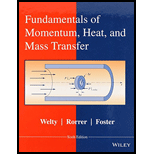
Interpretation:
The force exerted on the given device in an upward direction by water and air is to be calculated. Also, explain why Bernoulli’s equation is not used in the calculation of the force.
Concept Introduction:
The general energy balance equation according to the first law of
The general equation written for the overall linear momentum balance for a controlled volume is:
Here, C.S is the control surface over which the integral dA is taken, C.V is the control volume over which the integral dV is taken,
Want to see the full answer?
Check out a sample textbook solution
Chapter 6 Solutions
Fundamentals of Momentum, Heat, and Mass Transfer
- Please solve 5.2 (a) and (b)arrow_forward3. Review the figure below and mark it to indicate where relief devices should be placed. Nitrogen Purge Hexane Storage Water Polymer Storage Polymer Steam- HIC HIC (TIC) (TIC Hexane Coolers #FIC) (W) (PIC (PIC) PD Pump Centrifuge #FIC)arrow_forward2. Review the figure below and mark it to indicate where relief devices should be placed. Steam- Nitrogen (Purge Gas) Crude Methanol PD Pump HIC ☑D TIC TC Water TIC Still Steam PD Pump Drum LIC PIC Tars Methanolarrow_forward
- Calculate the thickness of the square mica plates (in ft), having an area of 0.01 sq. is falling at a velocity of 5.0 cm through oil with a density of 55 lb/cu ft and with viscosity of 15 centipoise. The specific gravity of the mica is 3.0. Assume that the particle velocity reaches its maximum and so it becomes cement was, and stokes law applies.arrow_forwardCalculate the thickness of the square mica plates (in ft), having an area of 0.01 sq. is falling at a velocity of 5.0 cm through oil with a density of 55 lb/cu ft and with viscosity of 15 centipoise. The specific gravity of the mica is 3.0. Assume that the particle velocity reaches its maximum and so it becomes cement was, and stokes law applies.arrow_forwardLiquid ammonia (NH₃) is applied as a fertilizer. You are working for a company that applies the ammonia (they charge a lot for every pound they apply to the soil) and you keep track of the pounds of ammonia that has been applied from the tank on the back end of your pickup (four-wheel drive with big tires). After the liquid has been emptied from the tank, there is still gas ammonia left in the tank. It has been sitting in the sun and its temperature is 125°F. Also, the pressure gauge at the top of the tank shows 230 psig (pounds per square inch gauge). The tank has a volume of 120 ft³. How many pounds of ammonia are left in the tank?arrow_forward
- n-Hexane is burned with excess air. An analysis of the product gas yields the following dry-basis molar composition: 7.48% CO2, 1.45% CO, 0.556% C6H14 (with the remainder O2 and N2). The stack gas emerges at 760 mm Hg. Calculate the percentage conversion of hexane, the percentage excess air fed to the burner, and the dew point of the stack gas, taking water to be the only condensable species.arrow_forwardA piston-fitted cylinder with a 5-cm diameter contains 1.65 g of nitrogen. The mass of the piston is 6.50 kg, and a 35.0-kg weight rests on the piston. The gas temperature is 35.0°C, and the pressure outside the cylinder is 3.50 atm. d=5 m₁g N₂ m3kg dcm m2=6.50 m1 1.65 m3 = 35.0 Calculate the pressure in the cylinder. i x 105 Pa eTextbook and Media Save for Later Volume What is the volume of the gas in the cylinder? V = i L m2 kg If the 35.0 kg weight is removed from the piston, how far does the piston move up? i Save for Later m Heat Transferred A How much heat is transferred to (positive) or from (negative) the gas during the expansion? Jarrow_forwardchemical engineering The answer for the specific molar volume of nitrogen gas is 12.089x10^(-5) m^3/mol. How was this answer determined? You need to use the ideal gas law to determine the specific molar volume. Do not determine the third specific enthalpy.arrow_forward
- Using Raoult's law for water and Henry's law for nitrogen, calculate the pressure and gas-phase composition (mole fractions) in a system containing a liquid that is 0.500 mole% N2 and 99.50 mole% water in equilibrium with nitrogen gas and water vapor at 70.0 °C. The Henry's law constant for nitrogen in water is recommended by NIST to be well represented by KH = 0.000625 exp[1300 (1/T - 1/298.15)] mol N2/(kg H2O bar), where T is measured in Kelvin. Physical Property Tables Unit Conversion Check the unit conversions and examine the definition of H. Estimate the Henry's law constant H [atm/(mole fraction N2)] for nitrogen in water at T = 70.0 °C. i ! x 104 atm/(mole fraction N2)arrow_forwardcan you help me answer this, you can find what the data need in perry's chemical engineering handbook 9th editionarrow_forwardchemical engineering. Compressing hydrogen gas from 1 atm to 300 atm at 25 deg Celcius Determine the specific enthalpy.arrow_forward
 Introduction to Chemical Engineering Thermodynami...Chemical EngineeringISBN:9781259696527Author:J.M. Smith Termodinamica en ingenieria quimica, Hendrick C Van Ness, Michael Abbott, Mark SwihartPublisher:McGraw-Hill Education
Introduction to Chemical Engineering Thermodynami...Chemical EngineeringISBN:9781259696527Author:J.M. Smith Termodinamica en ingenieria quimica, Hendrick C Van Ness, Michael Abbott, Mark SwihartPublisher:McGraw-Hill Education Elementary Principles of Chemical Processes, Bind...Chemical EngineeringISBN:9781118431221Author:Richard M. Felder, Ronald W. Rousseau, Lisa G. BullardPublisher:WILEY
Elementary Principles of Chemical Processes, Bind...Chemical EngineeringISBN:9781118431221Author:Richard M. Felder, Ronald W. Rousseau, Lisa G. BullardPublisher:WILEY Elements of Chemical Reaction Engineering (5th Ed...Chemical EngineeringISBN:9780133887518Author:H. Scott FoglerPublisher:Prentice Hall
Elements of Chemical Reaction Engineering (5th Ed...Chemical EngineeringISBN:9780133887518Author:H. Scott FoglerPublisher:Prentice Hall
 Industrial Plastics: Theory and ApplicationsChemical EngineeringISBN:9781285061238Author:Lokensgard, ErikPublisher:Delmar Cengage Learning
Industrial Plastics: Theory and ApplicationsChemical EngineeringISBN:9781285061238Author:Lokensgard, ErikPublisher:Delmar Cengage Learning Unit Operations of Chemical EngineeringChemical EngineeringISBN:9780072848236Author:Warren McCabe, Julian C. Smith, Peter HarriottPublisher:McGraw-Hill Companies, The
Unit Operations of Chemical EngineeringChemical EngineeringISBN:9780072848236Author:Warren McCabe, Julian C. Smith, Peter HarriottPublisher:McGraw-Hill Companies, The





